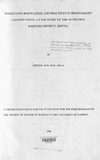Indigenous knowledge and Practices in biodiversity conservation:A case study of the Ilchamus, Baringo district, Kenya.
Abstract
The main objective of this study was to establish the role of indigenous knowledge and practices
in the conservation of woody plants' biodiversity, taking the Ilchamus of Baringo District as a
case study. The determination of the land use/cover dynamics of the area, was also an integral
part of the investigation. The study tested two working hypotheses, viz: (a) woody species
densities do not manifest significant variation with their respective utilization intensities and (b)
the assorted woody perennials preserved in the arable lands by the farmers are not significantly
different.
Mapping was achieved through the use of two sets of imageries; the 1973 LANDSAT,
Scene 181160 and 1987 SPOT, Scene 136-349. The intersection of the two imageries using a
computer-based Geographic Information System (GIS) enabled evaluation of the vegetation
dynamics in the area. In the field the Point Centred Quarter method was used to assess species
diversity, density and basal area along the transects.
Broadly, seven land use/cover classes were adopted: forest, woodland, shrubland,
grassland, riverine forest, irrigated land and bare ground. The Chi-square distribution and
Spearman's rank correlation were used to test the null hypotheses. Questionnaire administration
facilitated collection of socio-economic data while the Shannon Weiner index was used to
compute the species diversity. It is interesting, to note that forests were found to have expanded
as from 1973 to 1995 by about 990 ha. From the study it appeared that irrigation water, the
,
spread of Prosopis spp. (SW.) DC., as well as indigenous conservation practices had largely
contributed to the observed increase. However, on the average, vegetation coverage declined
by approximately 3201 ha over the same period.
The Ilchamus were found to practice a highly Cleveloped indigenous agro-forestry, with the
most preferred tree species being, Acacia tortilis, Forssk, Balanites aegyptiaca. (L.) Del. and
Salvadora persica L. Chi-Square test for the on-farm tree species was found to be significant
XIV -
(P < 0.01). These species were selected on the basis of their compatibility with crops and other
uses like firewood, fencing and medicinal purpose among others.
Herds' diversification which had played an important role in spreading the exploitative
pressure on the biological resources was a common practice among the Ilchamus. The Ilchamus
depended heavily on plants for most of their daily needs like firewood, construction materials,
and medicines. The people appreciated the importance of these biological resources and had
thereby developed indigenous models geared towards their conservation. In fact the Spearman's
rank correlation coefficient between the woody species density and their respective importance
was significant (P < 0.05) with r, = 0.55, suggesting commendable conservation efforts on the
part of the Ilchamus. This study concludes that rural people have an immense reservoir of
knowledge about their environment. In addition, they have well-developed indigenous structures
geared towards conservation of the environment and particularly biological resources on which
they depend heavily. However, due to their very low incomes the people often tend to engage
in practices that are ecologically counterproductive.
Given the inadequate empirical studies of this nature in Kenya and elsewhere, scholars,
policy makers and other relevant agents have not been able to appreciate fully the importance
of indigenous knowledge in conservation. This research is therefore expected to contribute
significantly through the documentation and evaluation of some aspects of these.
The study recommends the creation of an enabling environment for effective conservation
through the uplifting of the socio-economic status of the Ilchamus and ensuring individual land
tenure. Furthermore, the existing indigenous models of conservation need to be given the
necessary emphasis through participatory approaches. The impact of Prosopis spp. needs to be
addressed urgently in order to avoid ecologically-costly results. These, among other
recommendations, are proposed by this study for further research and/or remedial measures.

